preface to the anglo-american cataloguing rules, second edition
preface to the anglo-american cataloguing rules, second edition
preface to the anglo-american cataloguing rules, second edition
You also want an ePaper? Increase the reach of your titles
YUMPU automatically turns print PDFs into web optimized ePapers that Google loves.
apparent between <strong>the</strong>m and <strong>the</strong> programme initiated by IFLA, under <strong>the</strong> general headingof Universal Bibliographical Control (UBC), for <strong>the</strong> development of separate ISBDs forsuch materials as serials, maps, and nonbook materials.Seeking <strong>to</strong> establish means of uniform description for all materials, JSCAACR could noteasily reconcile AACR users’ needs with those of <strong>the</strong> UBC programme on two counts:(1) <strong>the</strong> timetables of AACR revision and UBC were not in phase with each o<strong>the</strong>r; and (2)although harmonized in general terms with ISBD(M), <strong>the</strong> available drafts from <strong>the</strong> newISBD working groups contained indications that in <strong>the</strong>ir final forms <strong>the</strong>y would beinsufficiently uniform in <strong>the</strong>ir relations with ISBD(M) and with each o<strong>the</strong>r; and thus <strong>the</strong>ymight be nei<strong>the</strong>r anticipated nor utilized in AACR as an integrated code.Mindful of its undertaking <strong>to</strong> <strong>the</strong> Council on Library Resources, JSCAACR <strong>to</strong>ok <strong>the</strong>initiative of proposing <strong>to</strong> <strong>the</strong> IFLA Committee on Cataloguing that a standardized generalframework, drawn up by joint edi<strong>to</strong>r Michael Gorman after scrutiny of <strong>the</strong> four mainsources for nonbook materials and of o<strong>the</strong>r sources, should be developed jointly byJSCAACR and IFLA as a constraint within which both AACR and <strong>the</strong> evolving specialmaterialISBDs should be held; so that <strong>the</strong> fullest uniformity might be achieved withinAACR, within ISBDs, and between ISBDs and AACR. The first meeting betweenJSCAACR (represented by all but one of its voting members and by both edi<strong>to</strong>rs) and <strong>the</strong>IFLA committee with <strong>the</strong> chairpersons of all <strong>the</strong> <strong>the</strong>n established ISBD working groupswas held in Paris in Oc<strong>to</strong>ber 1975, and substantial agreement was reached on <strong>the</strong>implementation of a general framework, <strong>to</strong> be known as ISBD(G). Fur<strong>the</strong>r agreement onsome modifications was reached at subsequent meetings, and part I of this <strong>edition</strong> isbased on <strong>the</strong> ISBD(G) framework determined by <strong>the</strong>se agreements.STRUCTURE AND WORKING METHODSIn each of <strong>the</strong> three participating countries <strong>the</strong> Joint Steering Committee’s work has beensupported and stimulated by a national committee, which initiated and/or screened verymany of <strong>the</strong> proposals for revision and <strong>the</strong>n reviewed and commented on <strong>the</strong> draft textsbefore <strong>the</strong>ir final form in this <strong>edition</strong> was settled.In <strong>the</strong> United States <strong>the</strong> ALA/RTSD Catalog Code Revision Committee (CCRC)organized rule review and revision proposal teams <strong>to</strong> identify systematically <strong>the</strong> <strong>rules</strong>needing attention and <strong>to</strong> make <strong>the</strong>ir own proposals in respect of <strong>the</strong>m, as well as <strong>to</strong>process those of o<strong>the</strong>r bodies. CCRC established working relations with o<strong>the</strong>rALA/RTSD groups, notably <strong>the</strong> Serials Section’s AACR Revision Study Committee, <strong>the</strong>Filing Committee, and with <strong>the</strong> Interdivisional Committee on Representation in Machine-Readable Form of Bibliographic Information (MARBI); and <strong>the</strong> entire membership of <strong>the</strong>Descriptive Cataloging Committee also participated in its work. Thirty organizationsoutside ALA were invited ei<strong>the</strong>r <strong>to</strong> designate representatives <strong>to</strong> CCRC or <strong>to</strong> receive andcomment on <strong>the</strong> Committee’s documents.In <strong>the</strong> United Kingdom a joint Library Association/British Library Committee onRevision of AACR, having equal representation from both organizations, performed asimilar task in respect of <strong>the</strong> British text. A close relationship was maintained with <strong>the</strong>Library Association Cataloguing and Indexing Group, under whose aegis consultationsand meetings with representatives of numerous o<strong>the</strong>r interest groups and organizations


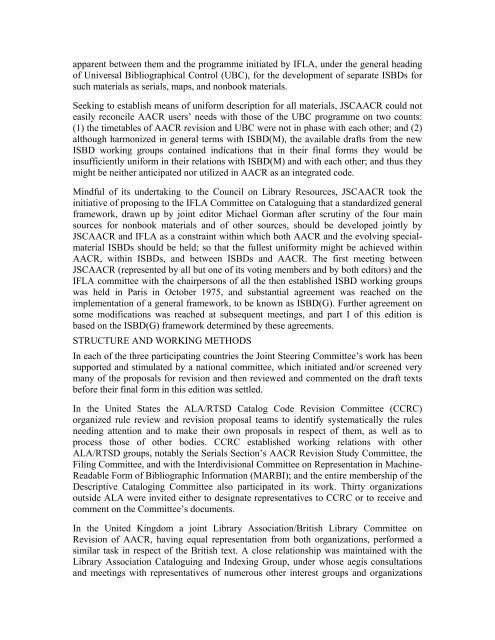

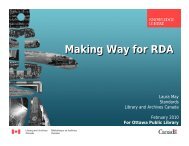
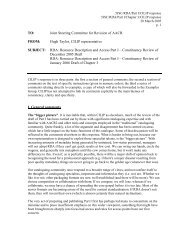
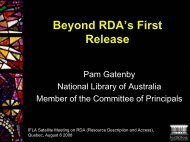

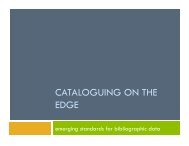

![Presentation slides [PDF] - Joint Steering Committee for ...](https://img.yumpu.com/41621230/1/190x143/presentation-slides-pdf-joint-steering-committee-for-.jpg?quality=85)

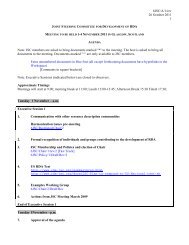
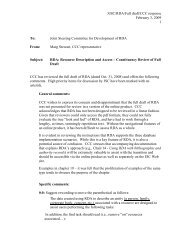
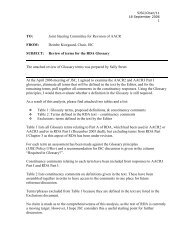
![Presentation slides [PDF] - Joint Steering Committee for ...](https://img.yumpu.com/35256207/1/190x143/presentation-slides-pdf-joint-steering-committee-for-.jpg?quality=85)
